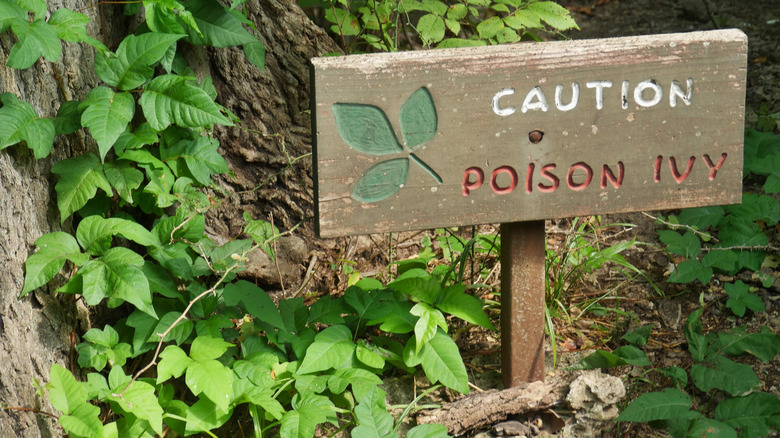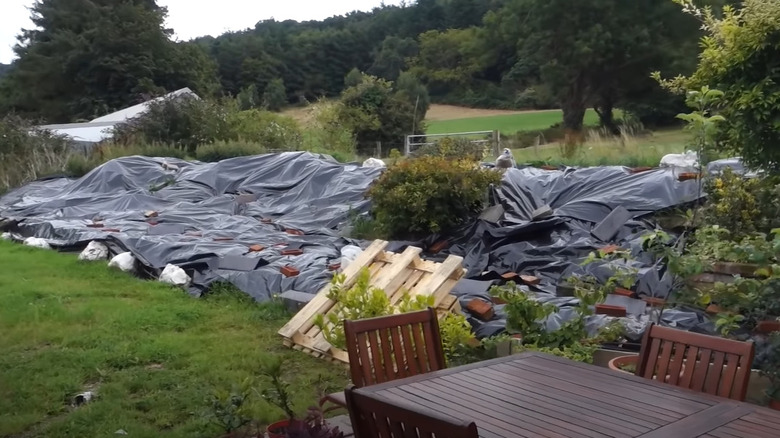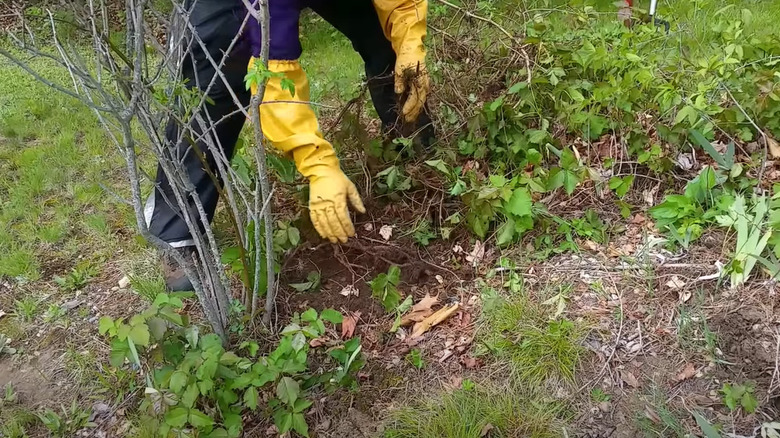Pinterest's Simple Fix For Getting Rid Of Fast-Spreading Poison Ivy Plants
The unwelcome guest that is poison ivy has no reservations about claiming territory, its voracious growth spurred by underground rhizomes and animal-dispersed seeds. You might have meticulously manicured every inch of your garden; however, it takes just a single seed, perhaps a gift from an overhead bird, and suddenly, you're starring in your very own poison ivy horror story. Killing and getting rid of poison ivy doesn't necessitate an onslaught of synthetic chemicals. Enter occultation, a novel yet straightforward Pinterest-endorsed weed control technique that involves smothering the invasive poison ivy with a black plastic sheet.
In this hack, the black sheet cuts off poison ivy's lifeline to essential resources. Deprived of water, sunlight, and oxygen and assailed by escalating soil temperatures, the plants beneath inevitably succumb. If you have a transparent plastic sheet on hand, that will suffice, employing the sun's wrath through solarization — this works over two to three scorching weeks. Although a slower process, requiring a minimum of one month, occultation offers a silent yet equally deadly blow to these green invaders.
However, outsmarting poison ivy is not a task taken lightly. Every inch of this menacing weed contains urushiol, the notorious oil behind haunting rashes and blisters. Alarmingly, this oil remains potent even in the plant's afterlife. Gearing up with all the necessary safety measures ensures you come out victorious without any battle scars.
How to smother poison ivy with opaque materials
Don yourself in protective gear before taking on poison ivy — a long-sleeved shirt, long pants, and gloves, as if preparing for an epic duel. Even better, duct tape the juncture between your pants and boots. Should the notorious plant manage a sneak attack, be swift to apply soapy water, running water, rubbing alcohol (frequent rinses will suffice here), or manganese sulfate solution on the contact area on your skin.
The primary tool for this task is a dark, dense, and wide plastic tarp. Deploy this canopy over the poison-ivy-infested area. That should smother the green foe beneath a blanket of darkness from which no photosynthetic life can emerge. Secure the tarp's perimeter with straw bales, hefty rocks, sandbags, logs, or bricks, ensuring no rogue leaf can find sanctuary at the edge. Alternatively, plunge the tarps' edges into the earth. The mission mandates patience; let this setup work for at least four weeks. In addition, keep your eyes peeled for roots seeking escape and extend your covering as required.
Now, picture the poison ivy, once a verdant beast, sprawled lifeless beneath your tarp. Proceed with caution to uproot the dead ivy and seal it in heavy-duty plastic bags for disposal. Doing so guarantees you remove all traces of the plant without spreading any oils or allowing it to regrow. Follow these steps diligently, and you'll reclaim your space from poison ivy without irritation or rashes.
Alternatives and precautions for smothering poison ivy
Before positioning your covering, clear away stalks, roots, sharp rocks, and other potential hazards using a rake. You wouldn't want these saboteurs puncturing the plastic, opening backdoors for poison ivy to breathe. Equally important, clothes worn during the operation should be regarded with a biohazard caution. Wash them separately to prevent innocent garments from becoming collateral damage if exposed to urushiol. Plastic bread bags fastened with rubber bands make for practical makeshift gloves.
Other light-blocking substitutes, like layers of newspaper, can also cloak your poison-ivy-infested area from the sun's life-giving rays. But here's an exciting twist: transparent plastic material can also suffocate the green invaders, not by cutting off sunlight, but by harnessing it. Enter solarization — it cooks these uninvited guests under intense summer heat. It's about cranking up the soil temperature beneath the clear plastic, transforming the environment into a poison ivy death trap.
A mistake to avoid when dealing with poison ivy is torching the subdued plant. Burning poison ivy, whether it's dead or alive, is like igniting a fuse of airborne urushiol, the catastrophe you initially armored against. For mild infestation of poison ivy, hand-pulling can be a winning strategy. However, in yards with plants you wish to protect, spot-spraying selective herbicide becomes your precision strike against poison ivy during its aggressive growth in late spring or early summer.


